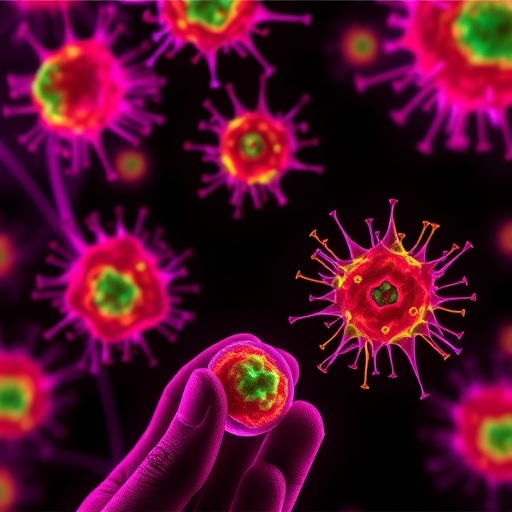
In the relentless pursuit to enhance immunotherapy against cancer, scientists have taken an innovative leap by expanding the repertoire of cytokine receptor signaling to reprogram T cells into diverse functional states. A groundbreaking study recently published in Nature elucidates how engineering human T cells with a human orthogonal chimeric IL-4 receptor (ho4R) can decisively redirect their differentiation toward type 2 phenotypes, thereby amplifying their anti-tumor activity in a melanoma xenograft model. This strategy represents a paradigm shift in cellular immunotherapy, offering a promising foothold in overcoming the limitations of current cell-based cancer therapies.
T cell plasticity is a central theme in the immune response against tumors, and modulating specific cytokine receptor pathways is an attractive avenue to harness this plasticity therapeutically. The new approach taken by the research team involves constructing an orthogonal signaling system whereby the IL-4 receptor is engineered to respond exclusively to a modified IL-2 cytokine, dubbed human orthogonal IL-2 (hoIL-2). The chimeric receptor, ho4R, essentially couples IL-2 engagement with IL-4 receptor signaling cascades, fueling T cell differentiation programs associated with type 2 cytokine production, including IL-4, IL-5, and IL-13.
To interrogate the functional consequences of this synthetic cytokine receptor architecture, human T cells were genetically modified to express the ho4R fused with a defined T cell receptor (TCR) specific for the melanoma-associated antigen NY-ESO-1 presented by HLA*0201. When cultured with the engineered cytokine MSA–hoIL-2, the ho4R-expressing TCR-T cells showed a pronounced enrichment of T helper 2 (T_H2) and cytotoxic T type 2 (T_C2) cells. This shift was marked by significant increases in intracellular production of hallmark type 2 cytokines, with IL-4+, IL-5+, and IL-13+ subpopulations markedly expanded among both CD4+ and CD8+ T cell compartments when compared to non-transduced controls.
.adsslot_G0Iusp5WyM{width:728px !important;height:90px !important;}
@media(max-width:1199px){ .adsslot_G0Iusp5WyM{width:468px !important;height:60px !important;}
}
@media(max-width:767px){ .adsslot_G0Iusp5WyM{width:320px !important;height:50px !important;}
}
ADVERTISEMENT
One striking feature of this engineered signaling was its capacity to promote hybrid phenotypes co-expressing IFNγ alongside type 2 cytokines. This dual cytokine expression challenges the traditional dogma of rigid and mutually exclusive T cell polarization, highlighting a versatile and potentially more effective effector profile. Moreover, flow cytometric analyses revealed that the transcription factor GATA3, a master regulator of type 2 differentiation, was substantially upregulated in ho4R-modified cells, alongside elevated CCR4 expression, affirming the genuine induction of a type 2 molecular program.
These in vitro phenotypic changes translated into significant therapeutic impact in vivo. Administering the ho4R-engineered NY-ESO-1 TCR-T cells into immunodeficient NSG mice bearing subcutaneous melanoma tumors yielded profound tumor suppression compared to treatment with conventional TCR-T cells. Simultaneous systemic delivery of MSA–hoIL-2 ensured selective activation of the orthogonal receptor signaling axis, enhancing the persistence and functionality of the engineered T cells in the hostile tumor microenvironment.
Further in vivo analyses underscored the durability of type 2 differentiation prompted by ho4R signaling. Spleen-resident T cells from treated mice demonstrated remarkably elevated frequencies of IL-4+, IL-5+, and IL-13+ subsets without measurable systemic toxicity or weight loss, an important consideration for clinical translation. This confirms that synthetic cytokine receptor-ligand pairs can establish new immunological niches conducive to tumor control while maintaining an acceptable safety profile.
Mechanistically, the indispensability of GATA3 in mediating the antitumor efficacy of ho4R T cells was conclusively demonstrated by CRISPR/Cas9-dependent knockout experiments. Loss of GATA3 completely abolished the therapeutic benefits, indicating that the engineered IL-4 receptor signaling operates through canonical transcriptional regulators to effectuate sustained type 2 programs necessary for immune-mediated tumor destruction.
Importantly, blocking one or multiple type 2 cytokines in vitro did not impair the antitumor functionality, implying either redundancy or compensatory mechanisms within the cytokine network elicited by this synthetic signaling. This highlights an advantage of orthogonal receptor systems in activating complex cellular programs which may be resilient to single-cytokine interruptions, potentially overcoming resistance mechanisms observed in conventional immunotherapies.
This research heralds a new frontier wherein the cytokine receptor alphabet can be expanded and rewired to empower T cells with bespoke functional states tailored for specific therapeutic applications. By decoupling receptor activation from endogenous ligands and creating orthogonally selective cytokine-receptor pairs, scientists have unlocked nuanced control over immune cell fate decisions.
The implications of this approach extend beyond cancer. The ability to engineer T cell polarization with high precision offers prospects for improved treatments of autoimmune diseases, allergies, and infectious diseases, where fine-tuning immune responses is critical. The modular nature of chimeric cytokine receptors also opens avenues to design synthetic immune circuits responsive to customized inputs, pushing the boundaries of synthetic immunology.
Moreover, the demonstrated efficacy of ho4R signaling in concert with orthogonal IL-2 agonists establishes a platform for safer, more controllable adoptive cell transfer therapies. This could greatly reduce systemic toxicities and cytokine release syndromes by restricting potent cytokine stimulation to engineered cells expressing matching orthogonal receptors.
This advance underscores the importance of synthetic biology tools in immunoengineering, moving beyond simple receptor overexpression to complex reprogramming of intracellular signaling networks. Future studies will undoubtedly explore combinatorial cytokine receptor designs to generate multifunctional T cells capable of adapting dynamically to tumor microenvironments and overcoming diverse immunosuppressive barriers.
As the field moves forward, integrating orthogonal cytokine receptor systems with genomic editing and high-dimensional phenotyping will refine the potency, stability, and safety of engineered T cells. Such approaches may eventually culminate in off-the-shelf cellular therapies with tunable effector profiles optimized for individual patient tumors.
In conclusion, this study leverages synthetic cytokine receptor engineering to successfully rewire T cell fate decisions and amplify anti-cancer immunity. By introducing a human orthogonal IL-4 receptor and its cognate ligand, researchers have created a robust framework for generating durable type 2 T cell responses with enhanced therapeutic efficacy. This innovative platform holds the potential to reshape adoptive T cell therapies across oncology and beyond, providing a compelling blueprint for the next generation of precision immunotherapy.
Subject of Research: Engineering T cells with human orthogonal chimeric IL-4 receptor signaling to induce type 2 differentiation and enhance anti-tumor activity in melanoma models.
Article Title: Expanding the cytokine receptor alphabet reprograms T cells into diverse states.
Article References:
Zhao, Y., Ogishi, M., Pal, A. et al. Expanding the cytokine receptor alphabet reprograms T cells into diverse states. Nature (2025). https://doi.org/10.1038/s41586-025-09393-1
Image Credits: AI Generated
Tags: cellular immunotherapy strategiesCytokine receptor engineeringenhancing anti-tumor activityhuman orthogonal chimeric receptorsIL-4 receptor modificationsimmunotherapy advancements in cancer treatmentmelanoma xenograft model in researchnovel approaches to cancer treatmentsynthetic biology in immunotherapyT cell plasticity and differentiationT cell reprogramming for cancer therapytype 2 cytokine production in T cells





